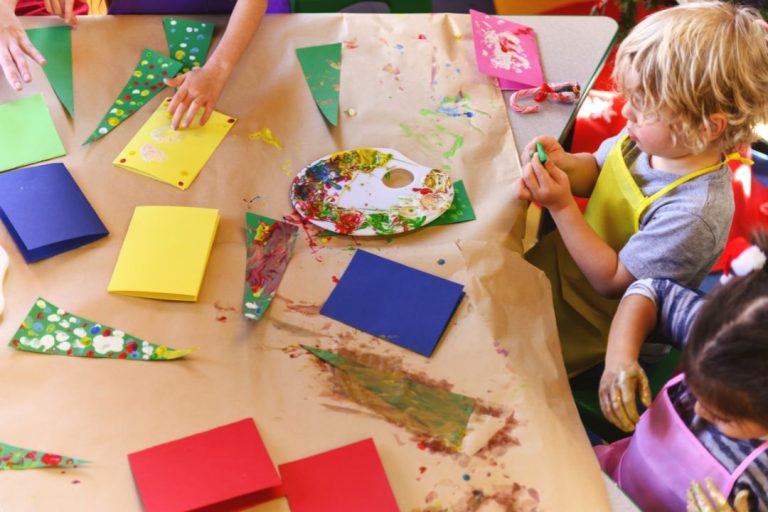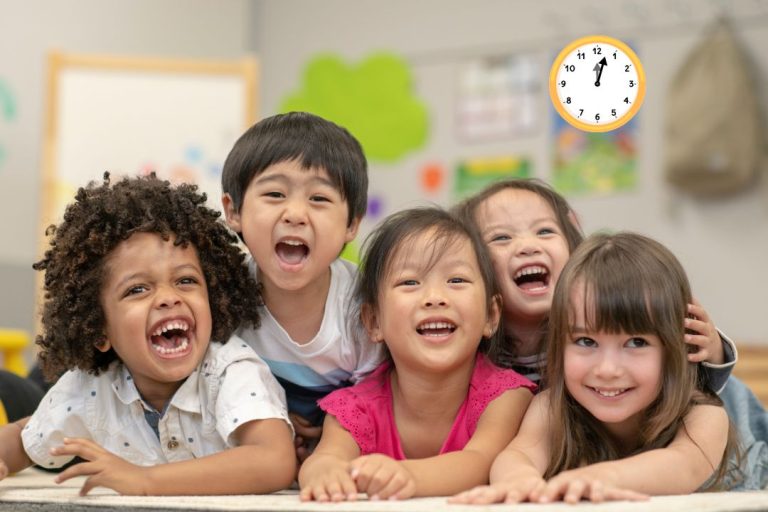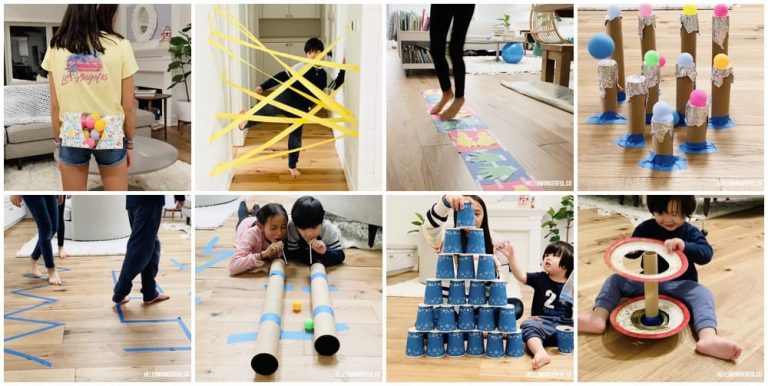How to Create a Positive Classroom Environment in Early Education

To create a positive classroom environment in early education, establish clear expectations and rules. Encourage positive behavior and provide opportunities for students to actively engage in learning.
Support social and emotional development through activities and discussions, and foster a sense of belonging and inclusion among students. Recognize and celebrate individual achievements and promote a supportive and respectful atmosphere. A positive classroom environment is crucial for the overall development of young children.
It sets the stage for a successful learning experience and helps in nurturing their social, emotional, and cognitive skills. By implementing strategies that promote positivity and inclusivity, educators can create a space where every child feels valued and supported. This article explores effective ways to establish a positive classroom environment in early education, providing educators with valuable insights into creating a conducive and enriching learning environment for young learners.
Engaging Early Learners
Engaging early learners in the classroom is essential for creating a positive and stimulating environment. By implementing strategies that cater to the unique needs of young students, educators can foster a love for learning that will last a lifetime. In this section, we’ll explore how to craft an inclusive atmosphere, methods to encourage student collaboration, and the importance of physical space arrangement in engaging early learners.
Crafting An Inclusive Atmosphere
Creating an inclusive classroom atmosphere is crucial for ensuring that all early learners feel valued and respected. This can be achieved by:
- Celebrating diversity: Acknowledge and celebrate the different backgrounds, cultures, and abilities present in the classroom.
- Use inclusive language: Incorporate language and materials that are representative of all students, avoiding stereotypes and biases.
Methods To Encourage Student Collaboration
Encouraging early learners to collaborate fosters a sense of community and teamwork. Some effective methods include:
- Group projects: Assigning group projects allows students to work together, share ideas, and learn from one another.
- Peer teaching: Allowing students to take turns teaching their peers reinforces their own understanding while promoting collaboration.
Importance Of Physical Space Arrangement
The physical arrangement of the classroom plays a significant role in engaging early learners. Consider the following:
| Factors to Consider | Implementation |
|---|---|
| Accessibility: Ensure that materials and resources are easily accessible to all students, promoting independence. | Arrange shelves and storage units at an appropriate height for young learners. |
| Designated learning zones: Create designated areas for various activities, such as reading corners, art stations, and collaborative workspaces. | Use rugs, partitions, and furniture to define different areas within the classroom. |
Positive Environment Fundamentals
Creating a positive classroom environment in early education is key to fostering a nurturing and supportive space where young learners can thrive. The fundamental elements of a positive environment are imperative for shaping a child’s overall development and future success. Let’s delve into the crucial aspects of understanding the role of teacher attitudes, encouraging respect and trust, and building a supportive classroom culture.
Understanding The Role Of Teacher Attitudes
Teacher attitudes play a pivotal role in shaping the classroom’s atmosphere. Educators should aim to exhibit positivity, empathy, and enthusiasm in their interactions with students. When teachers demonstrate a genuine passion for teaching and foster a warm and approachable demeanor, it sets the tone for a welcoming and supportive environment that engages and uplifts young minds.
Encouraging Respect And Trust
Respect and trust are foundational components of a positive classroom environment. Teachers should cultivate an atmosphere where each student feels valued and respected. This can be achieved by actively listening to students, addressing their concerns, and setting clear expectations for respectful behavior. When children feel heard and understood, it fosters a sense of trust and mutual respect within the classroom.
Building A Supportive Classroom Culture
Building a supportive classroom culture involves creating an environment where students feel safe to express themselves and take academic risks. Teachers can achieve this by promoting collaboration, offering encouragement and constructive feedback, and fostering a growth mindset that celebrates mistakes as learning opportunities. Emphasizing the value of teamwork and inclusivity contributes to a cohesive and supportive classroom culture.
Incorporating Play In Learning
When it comes to creating a positive classroom environment in early education, incorporating play in learning is essential. Playful teaching methods can significantly impact a child’s cognitive and social development. Children learn best when they are engaged and having fun, and integrating play into educational activities can foster a positive and enriching learning experience.
Emphasizing Fun In Educational Activities
Emphasizing fun in educational activities is crucial for capturing children’s attention and keeping them engaged. By incorporating games, music, and interactive exercises, educators can create a lively and enjoyable learning environment. By infusing joy and excitement into the learning process, children are more likely to be enthusiastic and motivated to participate in classroom activities.
Benefits Of Playful Teaching Methods
Playful teaching methods offer numerous advantages for early education. They promote creativity, problem-solving skills, and social interaction. Engaging in play-based learning can enhance children’s cognitive abilities, emotional development, and language skills. Additionally, it fosters a positive attitude towards learning and encourages active participation in classroom discussions and activities, ensuring their holistic development.
Selecting Age-appropriate Learning Materials
Providing age-appropriate learning materials is vital in creating an effective play-based learning environment. Educators should select toys, games, and activities that align with the developmental stage and interests of the children. Adapting the learning environment to match their needs ensures that the play experience is both enjoyable and educational, promoting optimal learning outcomes.
Behavior Management Strategies
When it comes to creating a positive classroom environment in early education, effective behavior management strategies play a crucial role. By implementing clear classroom rules, positive reinforcement techniques, and conflict-resolution skills, educators can foster a harmonious and conducive learning environment for young learners.
Establishing Clear Classroom Rules
Establishing clear classroom rules is essential in promoting positive behavior among early education students. The rules should be clearly communicated to the students and consistently enforced. Educators can create a set of simple and easy-to-understand rules, such as respecting others, listening attentively, and following instructions. By setting clear expectations, students are more likely to understand the boundaries and behave accordingly.
Positive Reinforcement Techniques
Positive reinforcement techniques, such as verbal praise, stickers, or small rewards, can be powerful motivators for young children. When students demonstrate positive behaviors, acknowledging and rewarding their efforts can reinforce these desirable actions. Building a system of rewards for good behavior encourages a positive classroom culture and reinforces the importance of following the established rules.
Developing Effective Conflict Resolution Skills
Developing effective conflict resolution skills equips young students with the necessary tools to address disputes and disagreements constructively. Educators can teach students problem-solving techniques, active listening, and empathy, empowering them to resolve conflicts peacefully. By fostering a supportive and collaborative atmosphere, early education classrooms can become spaces where students learn to navigate interpersonal challenges positively and respectfully.
Cultivating Emotional Intelligence
Developing emotional intelligence is essential in early education to help children build resilience, form positive relationships, and navigate social interactions. By teaching empathy and emotional awareness, providing activities to enhance social skills, and fostering strong teacher-student connections, educators can create a positive classroom environment that nurtures emotional intelligence in young learners.
Teaching Empathy And Emotional Awareness
Empathy is a fundamental aspect of emotional intelligence that allows children to understand and connect with the feelings of others. By incorporating activities and discussions that encourage students to recognize and empathize with the emotions of their peers, teachers can foster a supportive and compassionate classroom community. Implementing role-playing scenarios, reading books with diverse characters and emotions, and discussing real-life situations can enhance students’ empathy and emotional awareness.
Activities To Enhance Social Skills
Engaging in cooperative play, collaborative projects, and group discussions can help children develop essential social skills such as communication, teamwork, and conflict resolution. By providing opportunities for interactive games, team-building exercises, and collaborative learning experiences, educators can promote social skill development in a positive and inclusive classroom environment.
Importance Of Teacher-student Connections
The relationships between teachers and students play a crucial role in nurturing emotional intelligence. Establishing a supportive and trusting rapport can create a safe space for children to express their emotions, seek guidance, and build confidence. By actively listening to students, offering encouragement, and acknowledging their emotions, teachers can empower young learners to develop a deeper understanding of themselves and others.
Fostering A Growth Mindset
Creating a positive classroom environment in early education involves fostering a growth mindset among students. A growth mindset is the belief that abilities and intelligence can be developed through dedication and hard work. When students embrace a growth mindset, they are more likely to be resilient, embrace challenges, and persist in the face of setbacks. Here’s how to foster a growth mindset in the classroom:
How To Create A Positive Classroom Environment With Encouragement
Encouragement plays a pivotal role in nurturing a growth mindset. Teachers should praise effort and progress rather than only focusing on the end result. By providing positive reinforcement, students feel empowered to take risks, make mistakes, and learn from them. Moreover, creating an atmosphere of support and understanding helps students build confidence and resilience.
Overcoming Challenges Through Perseverance
Teaching students the value of perseverance is crucial in developing a growth mindset. Encouraging them to tackle difficult tasks and persistence when faced with obstacles helps them understand that challenges are growth opportunities. By fostering a ‘never give up’ attitude, students are motivated to keep trying and improving, leading to enhanced problem-solving skills and resilience.
Celebrating Effort And Not Just Success
Recognizing and celebrating effort is essential for instilling a growth mindset. Emphasizing that progress and improvement are more important than achieving a perfect outcome encourages students to take risks and embrace challenges. By acknowledging their hard work and celebrating small victories, students feel valued and motivated to continue their learning journey.
Parental Involvement And Support
Parental involvement and support play a crucial role in creating a positive classroom environment in early education. When parents actively engage in their child’s education, it fosters a sense of partnership between home and school, leading to better academic and social outcomes for young learners.
Communication Strategies With Parents
Effective communication with parents is vital for building a strong foundation of trust and understanding. Open and transparent communication can be facilitated through various channels, such as regular newsletters, parent-teacher conferences, and digital platforms. Teachers can also utilize communication apps or platforms to provide timely updates on the child’s progress and upcoming events, ensuring parents feel informed and involved in their child’s educational journey.
Home-school Collaboration For Consistency
Creating a consistent experience for young learners requires seamless collaboration between home and school. Teachers can encourage parents to reinforce learning at home by providing clear guidance on homework assignments, study materials, and educational activities. Establishing a consistent routine and approach to learning ensures that children receive reinforcement and support both at school and at home, contributing to their overall academic success.
Engaging Family In The Educational Process
Engaging the entire family in the educational process can enhance the learning experience for early education students. Organizing family-oriented activities such as parent workshops, family reading nights, and cultural celebrations can foster a sense of community and involvement. By involving extended family members, such as grandparents, aunts, and uncles, educators can create a supportive network that extends beyond the classroom, enriching the educational journey for young learners.
Tailored Learning Approaches
Personalized instruction plays a crucial role in fostering a positive classroom environment in early education. Tailoring learning approaches to meet the diverse needs of students creates an inclusive and supportive atmosphere where every child feels valued and capable of success.
Personalizing Instruction For Diverse Needs
Personalized instruction involves adjusting educational content, learning pace, and teaching methods to cater to the unique learning styles and abilities of each child. By recognizing and addressing the diverse needs of students, educators can create an environment that fosters engagement, motivation, and a sense of belonging.
How To Create A Positive Classroom Environment Through Differentiation
Differentiation is key to creating a positive classroom environment. By offering a variety of learning activities and using flexible grouping strategies, educators can ensure that all students are actively engaged and supported in their learning journey. Individualized attention and practice, incorporating students’ interests, and fostering a culture of respect and collaboration are essential elements of differentiation.
Utilizing Technology To Enhance The Learning Experience
Integrating technology into the classroom can greatly enhance the learning experience, allowing educators to offer personalized and interactive learning opportunities. Adaptive learning software, educational apps, and digital resources can be leveraged to provide tailored instruction and support to students with diverse needs, while also promoting independent exploration and critical thinking skills.
Continuous Professional Development
In early education, creating a positive classroom environment requires continuous professional development for educators. This ensures that they stay updated with new educational techniques, reflect on their teaching practices, and remain committed to lifelong learning in education. Embracing new educational techniques, reflecting on teaching practices, and having a commitment to lifelong learning are crucial elements in fostering a positive and effective learning environment for young students.
Embracing New Educational Techniques
Educators should be open to embracing new educational techniques to enhance their teaching practices and student engagement. This involves staying informed about the latest research and methodologies in early childhood education, such as play-based learning, inquiry-based learning, and integrating technology in the classroom.
Reflecting On Teaching Practices
Reflecting on teaching practices allows educators to evaluate their strategies, identify areas for improvement, and adapt their approaches to better meet the needs of their students. It involves self-assessment, seeking feedback from colleagues and supervisors, and actively reflecting on the impact of their teaching on student learning.
Commitment To Lifelong Learning In Education
Committing to lifelong learning in education means that educators are dedicated to their professional growth and development throughout their careers. This includes pursuing additional certifications, attending workshops and conferences, and continually seeking opportunities to expand their knowledge and skills in early childhood education.

Frequently Asked Questions Of How To Create A Positive Classroom Environment In Early Education
How Can Educators Promote A Positive Classroom Environment In Early Education?
Educators can promote a positive classroom environment by setting clear expectations, fostering positive relationships, and creating a supportive and inclusive atmosphere where every child feels valued and respected.
Why Is A Positive Classroom Environment Important For Early Education?
A positive classroom environment is crucial for early education as it enhances learning, boosts children’s confidence, encourages social and emotional development, and creates a safe space for students to explore, engage, and thrive.
What Are Some Strategies To Cultivate A Positive Classroom Environment In Early Education?
Strategies to cultivate a positive classroom environment include implementing effective classroom management techniques, promoting collaborative learning experiences, integrating social-emotional learning into the curriculum, and utilizing positive reinforcement to recognize students’ efforts and achievements.
How Does A Positive Classroom Environment Impact Students’ Overall Development?
A positive classroom environment contributes to students’ overall development by fostering a love for learning, nurturing their social and emotional well-being, enhancing their cognitive skills, and laying the foundation for a successful academic journey and future success.
Conclusion
In essence, creating a positive classroom environment in early education is crucial for fostering a love of learning and promoting social and emotional development in young children. By implementing strategies like setting clear expectations, promoting positive interaction, and providing a nurturing atmosphere, educators can cultivate a space where children thrive and flourish.
Additionally, incorporating the use of engaging and developmentally appropriate materials can further enhance the learning experience. As educators continue to prioritize the creation of positive classroom environments, they play a vital role in shaping the future of our youngest learners.

With over 20 years of experience in early childhood education, Jane brings a wealth of knowledge to Classroom Journey. She specializes in play-based learning and has a passion for inclusive education.






